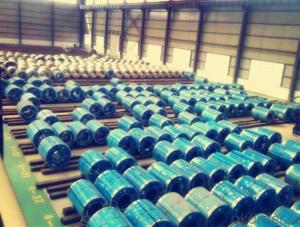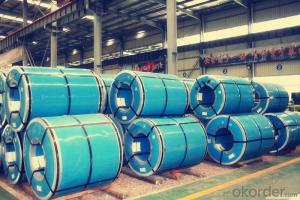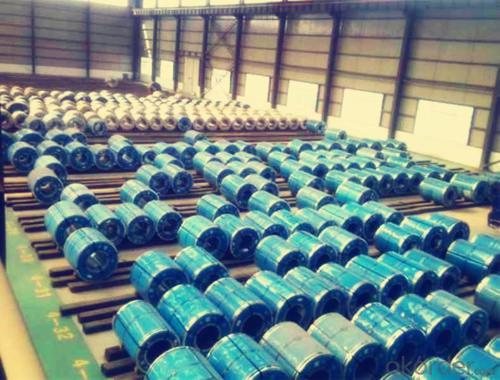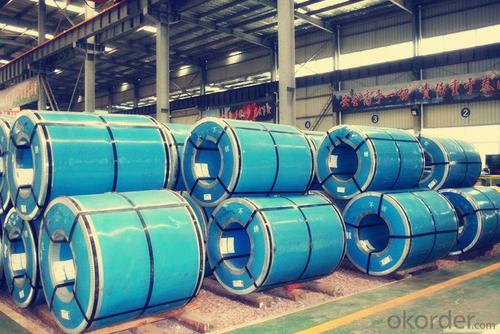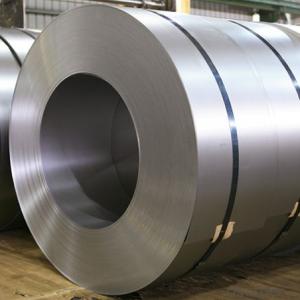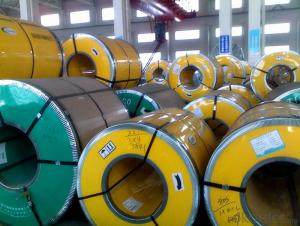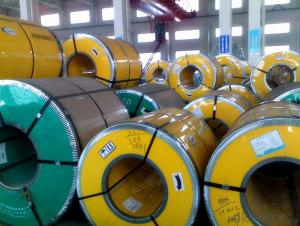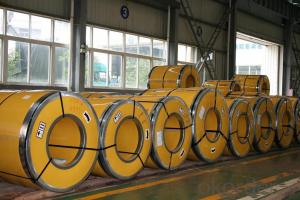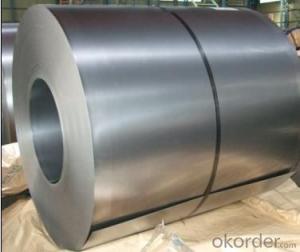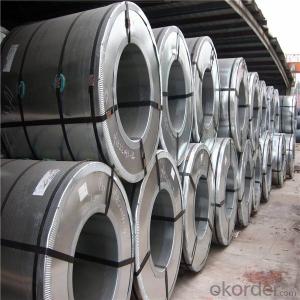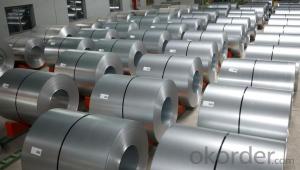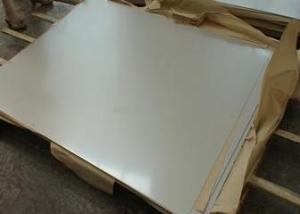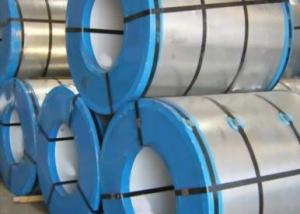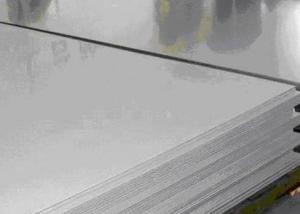Stainless Steel Coil/Sheet/Strip 304 Cold Rolled 2B/BA
- Loading Port:
- Ningbo
- Payment Terms:
- TT OR LC
- Min Order Qty:
- 100 m.t.
- Supply Capability:
- 20000 m.t./month
OKorder Service Pledge
OKorder Financial Service
You Might Also Like
Chemical composition: | |||||||
C | Si | Mn | Cr | Ni | S | P | |
≤0.07 | ≤1.0 | ≤2.0 | 18.0~20.0 | 8.0~11.0 | ≤0.03 | ≤0.035 | |
mechanical properties: | |||||||
Tensile strength σb (MPa) | Conditions yield strength 0.2 sigma (MPa) | Elongation δ5 (%) | Section shrinkage (%) | Hardness | |||
520 | 205 | 40 | 60 | ≤1 | |||
Hot Rolled Stainless Steel Coil 304 Annealing and Pickling No.1 Finish
Stainless steel is a production which not easy rust,acid resistance and corrosion resistance,so it is widely
used in light industry,heavy industry,daily necessities and the decoration industry.
Hot Rolled Stainless Steel Coil 304 Specifications
1.surface:NO.1
2.standard:JIS, AISI, GB
3.width: 0.55m, 0.65m, 1.0m, 1.22m, 1.5m, 2m or requirement
Hot Rolled Stainless Steel Coil 304 Chemical Composition:
(%):C=0.07, Mn=2.00, P=0.045, S=0.030, Si=0.075, Cr=17.5-19.5, Ni=8.0-10.5, N=0.10
Hot Rolled Stainless Steel Coil 304 Physical Properties
Tensile strength σb (MPa) ≥ 520
the conditions yield strength σ0.2 (MPa) ≥ 205,
elongation δ5 (%) ≥ 40
Reduction of ψ (%) ≥ 50,
hardness: ≤ 187
HB; ≤ 90
HRB; ≤ 200H
- Q: Can 111 stainless steel strips be formed into complex shapes?
- Yes, 111 stainless steel strips can be formed into complex shapes. Stainless steel is a highly versatile material that is known for its excellent formability. It can be easily bent, shaped, and manipulated into various complex geometries. The number of strips, in this case being 111, does not limit the ability to form complex shapes. The process of forming stainless steel strips into complex shapes may involve techniques such as bending, rolling, stamping, or welding, depending on the desired final shape. With the right tools, expertise, and techniques, stainless steel strips can be transformed into intricate and complex shapes for various applications in industries such as architecture, automotive, aerospace, and more.
- Q: What is the fatigue limit of stainless steel strips?
- The fatigue limit of stainless steel strips refers to the maximum stress level at which the material can endure an infinite number of stress cycles without experiencing fatigue failure.
- Q: What are the different surface finishes available for stainless steel strips?
- There are several surface finishes available for stainless steel strips, including mill finish, brushed finish, mirror finish, satin finish, and patterned finish.
- Q: What are stainless steel strips?
- Stainless steel strips are thin, elongated pieces of stainless steel that are commonly used in various industries for their corrosion resistance, durability, and aesthetic appeal. They are typically produced through a cold rolling process which results in a smooth and polished surface, making them ideal for applications such as construction, automotive, kitchenware, and electronic components.
- Q: Are stainless steel strips suitable for cryogenic storage?
- Yes, stainless steel strips are suitable for cryogenic storage. Stainless steel is known for its excellent strength, durability, and resistance to corrosion, making it an ideal material for cryogenic applications. Cryogenic storage involves extremely low temperatures, typically below -150 degrees Celsius (-238 degrees Fahrenheit), and stainless steel can withstand these extreme conditions without losing its structural integrity. Additionally, stainless steel has low thermal conductivity, which helps to minimize heat transfer and maintain the desired temperature within the cryogenic storage system. It is important to choose the appropriate grade of stainless steel for cryogenic storage to ensure it meets the required specifications and can withstand the specific conditions of the application.
- Q: Are 111 stainless steel strips suitable for architectural applications?
- Certainly, architectural applications can indeed benefit from the use of 111 stainless steel strips. Architects often prefer stainless steel for its exceptional durability, resistance to corrosion, and appealing visual qualities. The grade 111 stainless steel offers a cost-effective and easily obtainable option for a wide range of architectural uses, including wall cladding, roofing, handrails, and decorative elements. Nevertheless, it remains crucial to carefully assess the unique demands of each architectural project and seek guidance from experts to guarantee that the chosen material adheres to the essential standards and specifications.
- Q: Can stainless steel strips be used in the food and beverage industry?
- Yes, stainless steel strips can be used in the food and beverage industry. Stainless steel is widely used in this industry due to its corrosion resistance, durability, and hygienic properties. It is commonly used to manufacture equipment such as food processing machinery, storage tanks, conveyor systems, and brewing equipment. Stainless steel strips are versatile and can be formed into various shapes and sizes, making them suitable for a wide range of applications in the food and beverage industry.
- Q: Can stainless steel strips be used in food processing?
- Absolutely, stainless steel strips are perfectly suitable for food processing purposes. The food industry highly prefers stainless steel due to its exceptional resistance to corrosion and its hygienic properties. This material is completely non-reactive, ensuring that it won't affect the taste or quality of the food in any way. Food processing equipment, including conveyors, mixers, tanks, and cutting machines, frequently incorporate stainless steel strips. Their easy cleaning and maintenance make them an excellent choice for environments that demand stringent sanitation standards. Moreover, stainless steel is highly durable and can withstand high temperatures, making it an ideal option for a wide range of food processing applications.
- Q: What are the main properties of stainless steel strips?
- Stainless steel strips possess a multitude of desirable properties, making them highly sought after in a wide array of applications. To begin with, their exceptional resistance to corrosion is well-known. This resistance is primarily attributed to the presence of chromium in the steel, which creates a passive layer on the material's surface, safeguarding it against oxidation and corrosion. As a result, stainless steel strips can endure exposure to harsh environments, such as saltwater or acidic substances, without succumbing to rust or deterioration. Moreover, stainless steel strips demonstrate outstanding strength and durability. They boast a high tensile strength, enabling them to withstand significant stress and pressure without warping or fracturing. This renders them suitable for applications that necessitate structural integrity, such as in the construction or automotive industries. Additionally, stainless steel strips offer exceptional heat resistance. They retain their strength and structural integrity even when subjected to high temperatures, making them ideal for applications with heat exposure concerns, such as furnaces or exhaust systems. Another noteworthy property of stainless steel strips is their hygienic nature. Being non-porous and easy to clean, they prevent the growth of bacteria or other harmful microorganisms. Consequently, stainless steel strips find extensive use in the food and medical industries, where cleanliness and hygiene are of paramount importance. Lastly, stainless steel strips exhibit remarkable versatility and customizability. They can be fabricated into various shapes, sizes, and finishes to meet precise application requirements. Furthermore, they can be effortlessly welded, formed, or machined, facilitating simple assembly and customization during manufacturing processes. In conclusion, stainless steel strips possess exceptional corrosion resistance, high strength, heat resistance, hygienic properties, and versatility. These attributes establish stainless steel strips as the preferred choice in industries ranging from construction and automotive to food and medical.
- Q: What are the main properties of 111 stainless steel strips?
- The main properties of 111 stainless steel strips include high corrosion resistance, excellent mechanical properties, and good formability. These strips are made from austenitic stainless steel, which contains high levels of chromium and nickel. The high chromium content provides superior resistance to corrosion, making it suitable for various applications in industries such as automotive, aerospace, and construction. Additionally, 111 stainless steel strips possess excellent mechanical properties, such as high tensile strength and good impact resistance. This makes them ideal for applications that require strength and durability. Moreover, they exhibit good formability, allowing for easy shaping and fabrication into desired forms or components. Overall, 111 stainless steel strips offer a combination of corrosion resistance, mechanical strength, and formability, making them versatile and widely used in various industries.
Send your message to us
Stainless Steel Coil/Sheet/Strip 304 Cold Rolled 2B/BA
- Loading Port:
- Ningbo
- Payment Terms:
- TT OR LC
- Min Order Qty:
- 100 m.t.
- Supply Capability:
- 20000 m.t./month
OKorder Service Pledge
OKorder Financial Service
Similar products
Hot products
Hot Searches
Related keywords
